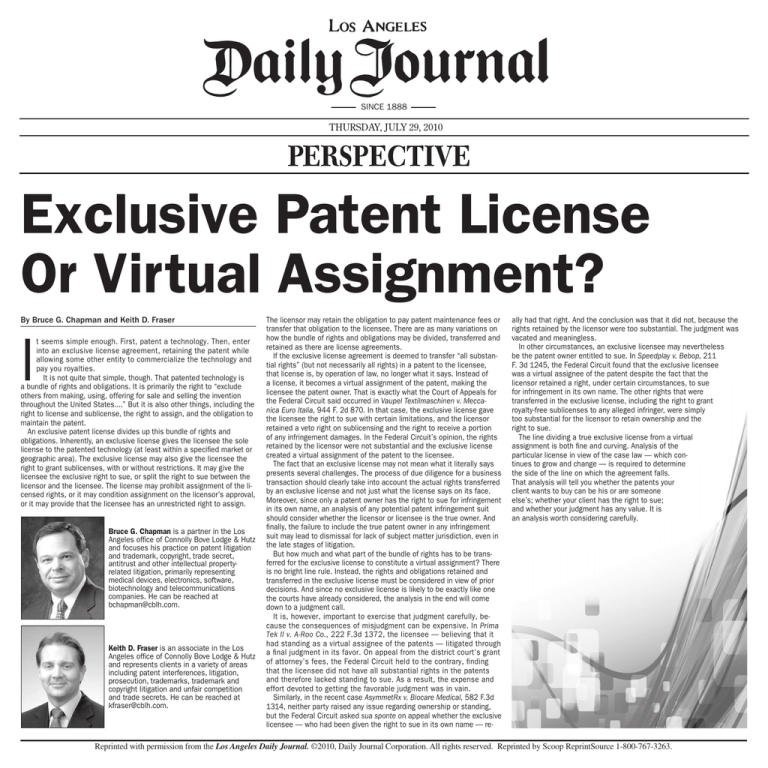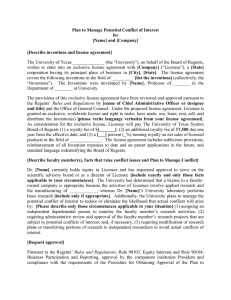
SINCE 1888
THURSDAY, JULY 29, 2010
Exclusive Patent License
Or Virtual Assignment?
By Bruce G. Chapman and Keith D. Fraser
I
t seems simple enough. First, patent a technology. Then, enter
into an exclusive license agreement, retaining the patent while
allowing some other entity to commercialize the technology and
pay you royalties.
It is not quite that simple, though. That patented technology is
a bundle of rights and obligations. It is primarily the right to “exclude
others from making, using, offering for sale and selling the invention
throughout the United States....” But it is also other things, including the
right to license and sublicense, the right to assign, and the obligation to
maintain the patent.
An exclusive patent license divides up this bundle of rights and
obligations. Inherently, an exclusive license gives the licensee the sole
license to the patented technology (at least within a specified market or
geographic area). The exclusive license may also give the licensee the
right to grant sublicenses, with or without restrictions. It may give the
licensee the exclusive right to sue, or split the right to sue between the
licensor and the licensee. The license may prohibit assignment of the licensed rights, or it may condition assignment on the licensor’s approval,
or it may provide that the licensee has an unrestricted right to assign.
Bruce G. Chapman is a partner in the Los
Angeles office of Connolly Bove Lodge & Hutz
and focuses his practice on patent litigation
and trademark, copyright, trade secret,
antitrust and other intellectual propertyrelated litigation, primarily representing
medical devices, electronics, software,
biotechnology and telecommunications
companies. He can be reached at
bchapman@cblh.com.
Keith D. Fraser is an associate in the Los
Angeles office of Connolly Bove Lodge & Hutz
and represents clients in a variety of areas
including patent interferences, litigation,
prosecution, trademarks, trademark and
copyright litigation and unfair competition
and trade secrets. He can be reached at
kfraser@cblh.com.
The licensor may retain the obligation to pay patent maintenance fees or
transfer that obligation to the licensee. There are as many variations on
how the bundle of rights and obligations may be divided, transferred and
retained as there are license agreements.
If the exclusive license agreement is deemed to transfer “all substantial rights” (but not necessarily all rights) in a patent to the licensee,
that license is, by operation of law, no longer what it says. Instead of
a license, it becomes a virtual assignment of the patent, making the
licensee the patent owner. That is exactly what the Court of Appeals for
the Federal Circuit said occurred in Vaupel Textilmaschinen v. Meccanica Euro Italia, 944 F. 2d 870. In that case, the exclusive license gave
the licensee the right to sue with certain limitations, and the licensor
retained a veto right on sublicensing and the right to receive a portion
of any infringement damages. In the Federal Circuit’s opinion, the rights
retained by the licensor were not substantial and the exclusive license
created a virtual assignment of the patent to the licensee.
The fact that an exclusive license may not mean what it literally says
presents several challenges. The process of due diligence for a business
transaction should clearly take into account the actual rights transferred
by an exclusive license and not just what the license says on its face.
Moreover, since only a patent owner has the right to sue for infringement
in its own name, an analysis of any potential patent infringement suit
should consider whether the licensor or licensee is the true owner. And
finally, the failure to include the true patent owner in any infringement
suit may lead to dismissal for lack of subject matter jurisdiction, even in
the late stages of litigation.
But how much and what part of the bundle of rights has to be transferred for the exclusive license to constitute a virtual assignment? There
is no bright line rule. Instead, the rights and obligations retained and
transferred in the exclusive license must be considered in view of prior
decisions. And since no exclusive license is likely to be exactly like one
the courts have already considered, the analysis in the end will come
down to a judgment call.
It is, however, important to exercise that judgment carefully, because the consequences of misjudgment can be expensive. In Prima
Tek II v. A-Roo Co., 222 F.3d 1372, the licensee — believing that it
had standing as a virtual assignee of the patents — litigated through
a final judgment in its favor. On appeal from the district court’s grant
of attorney’s fees, the Federal Circuit held to the contrary, finding
that the licensee did not have all substantial rights in the patents
and therefore lacked standing to sue. As a result, the expense and
effort devoted to getting the favorable judgment was in vain.
Similarly, in the recent case AsymmetRx v. Biocare Medical, 582 F.3d
1314, neither party raised any issue regarding ownership or standing,
but the Federal Circuit asked sua sponte on appeal whether the exclusive
licensee — who had been given the right to sue in its own name — re-
ally had that right. And the conclusion was that it did not, because the
rights retained by the licensor were too substantial. The judgment was
vacated and meaningless.
In other circumstances, an exclusive licensee may nevertheless
be the patent owner entitled to sue. In Speedplay v. Bebop, 211
F. 3d 1245, the Federal Circuit found that the exclusive licensee
was a virtual assignee of the patent despite the fact that the
licensor retained a right, under certain circumstances, to sue
for infringement in its own name. The other rights that were
transferred in the exclusive license, including the right to grant
royalty-free sublicenses to any alleged infringer, were simply
too substantial for the licensor to retain ownership and the
right to sue.
The line dividing a true exclusive license from a virtual
assignment is both fine and curving. Analysis of the
particular license in view of the case law — which continues to grow and change — is required to determine
the side of the line on which the agreement falls.
That analysis will tell you whether the patents your
client wants to buy can be his or are someone
else’s; whether your client has the right to sue;
and whether your judgment has any value. It is
an analysis worth considering carefully.
Reprinted with permission from the Los Angeles Daily Journal. ©2010, Daily Journal Corporation. All rights reserved. Reprinted by Scoop ReprintSource 1-800-767-3263.

